Spirea or meadowsweet is a beautifully flowering shrub, it develops rapidly and takes root pretty well in almost any environment. In landscape design, it often acts as a hedge and serves as an excellent complement to floral arrangements. Even the most unpretentious plants fully display decorative qualities only with proper care. It is important to take into account a few simple rules and the bush will become an adornment of the local area for 15–25 years. Spirea: care in the fall, preparation for winter and pruning, timing and useful recommendations.
Content
Features of the care and preparation of spirea for frost
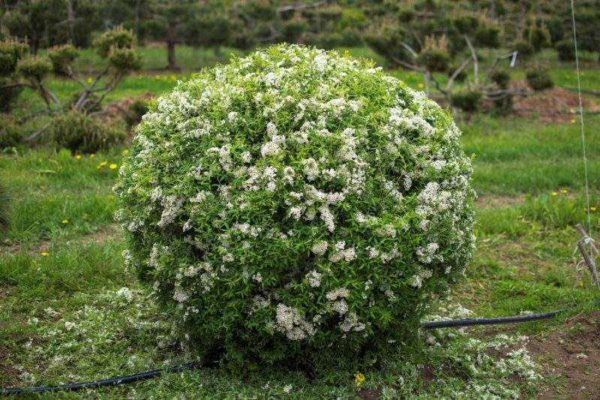
In order not to harm the bush with improper care in the fall, determining the need for certain works (watering, pruning and shelter), take into account the degree of resistance of a particular variety to low temperatures and the growing region. Most varieties of meadowsweet tolerate frosts from 35 to 50 degrees, in areas with a mild climate they can not be covered. For cold areas, as well as for heat-loving varieties, protection is mandatory. Features of spirea care in different regions:
- The middle lane, Moscow Region - if snowy winters are observed for several years in a row, it is not necessary to cover the branches of an adult bush, just rake the snow to the meadowsweet. And the roots will be enough mulch, covered with branches or spruce branches.
- Volga region - the bush is protected as in the previous case.
- Urals and Siberia - in cold regions, the most frost-resistant varieties are planted, adapted for a long cold period. Winter hiding is a mandatory procedure. The bushes are sheared before buds open, as significant autumn pruning will weaken the spirea before wintering.
After the fall, if the autumn was dry, pour about 15 liters of water under the bush, loosen the ground, in the case when the season was rainy there is no need for moisture. To protect the superficial root system, mulch the trunk circle with a mixture of leaves and peat 1: 1 or straw. In areas with harsh, snowless winters, it is better to organize an air-dry shelter. Before starting a haircut, carefully inspect the bush, if there is a cobweb on the branches, remove it. Treat the meadowsweet with a spider mite drug. Typical fall care spirea mistakes:
- do not water the bush before starting shelter, the roots rot from excess moisture, the meadowsweet dies;
- do not apply nitrogen-containing fertilizers;
- do not neglect the recommendations regarding the timing of pruning, if the procedure is done too late, the bush does not have time to recover and gain strength before the onset of severe frost;
- do not throw plant debris near the bush, burn them away from the garden.
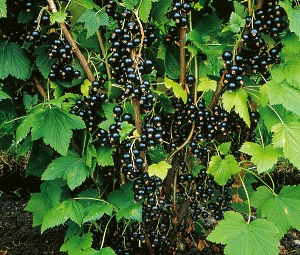 You may be interested in:
You may be interested in:Having spent a minimum of effort and time for autumn care, the next season you will enjoy the bright and abundant flowering of a lush, healthy bush. Failure to comply with these simple recommendations and insufficient study of the technology for growing shrubs as a whole can negatively affect its further development.A bush that is rapidly growing by nature can weakly build up green mass and lose immunity to diseases and pests.
How and When to Cut Spirea
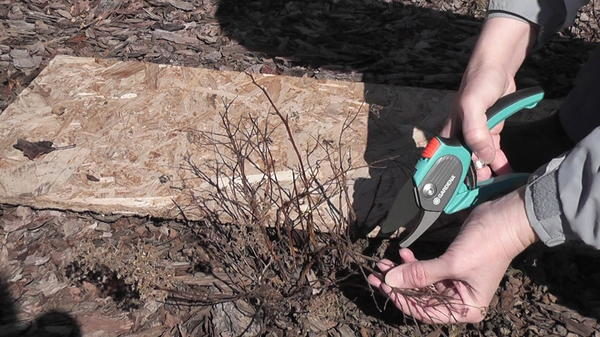
Someone transfers pruning in the spring, so as not to injure the shrub before hibernation, other gardeners believe that autumn mowing, on the contrary, increases the plant's resistance to low temperatures. According to professionals, the procedure is effective in any season. Each gardener himself determines when to cut the meadowsweet, based on their own capabilities and the condition of the bush. Use of trimming:
- the bush is well ventilated;
- a thinned plant receives more sunlight;
- the density of the bush increases (important when forming hedges);
- immunity to infections and pests is strengthened;
- the appearance of the bush improves;
- pruning stimulates the growth of green mass and the formation of buds.
The plant responds positively to shearing, regardless of variety and growing season. If you remove faded shoots in July, early flowering varieties will please with repeated flowering in September. In total there are 3 types of shrub pruning: shaping, rejuvenating and preventive. Autumn haircuts are carried out no earlier than 15 days before the onset of frost, so that the places of cuts can be tightened, in the spring - before the buds open.
| Haircut Type | Recommendations |
| Bush formation | Haircut can be carried out from the second or third year, so that the meadowsweet has a well-groomed appearance, cut the shoots protruding from the total green mass every year. Make sure that the maximum length of the cut stems does not exceed a third of the length of the annual growth. Starting at 4 or 5 years, cut the shoots in half. |
| Spirea Rejuvenation | Annual (moderate) rejuvenation is carried out every 2 or 4 years (preferably in the first half of September). Trim all stems 25–35 cm above the ground. If necessary, when the plant is more than 7 years old, you can radically rejuvenate the bush by cutting it to a stump (leave short stems with two or three buds). |
| Preventive pruning (from diseases and pests) | Cut to a healthy kidney all withered, dry and diseased branches. Also, non-overwintered shoots are subject to cutting, carry out the procedure as early as possible so that they do not take food from young branches. |
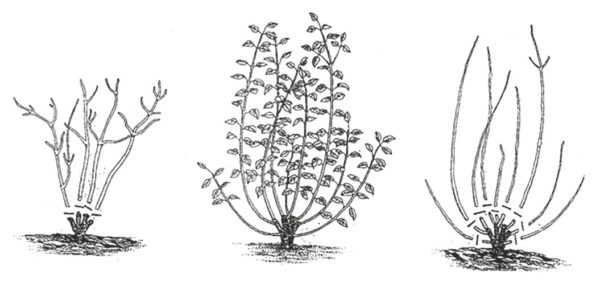
The aging or neglect of the meadowsweet can be judged by the presence of a large number of old branches and the almost complete absence of young growth. In critical cases, when the plant is severely affected by the disease, remove the branches to the level of the root neck, without leaving even short stumps. Buds from damaged parts of the bush will give weak and thin shoots. Check out the fall technology and trim scheme:
- strong, young stems of the last or current year do not need to be completely cut, shorten them. The exception is the extra shoots growing inside the crown;
- shoots have a lifespan of 5 years, completely remove old branches. On each shrub, regardless of variety, there should be more young branches than old ones, then the plant will be the most attractive and resistant to various adverse factors;
- in young stems, remove non-lignified tips, as well as cut off all dried inflorescences.
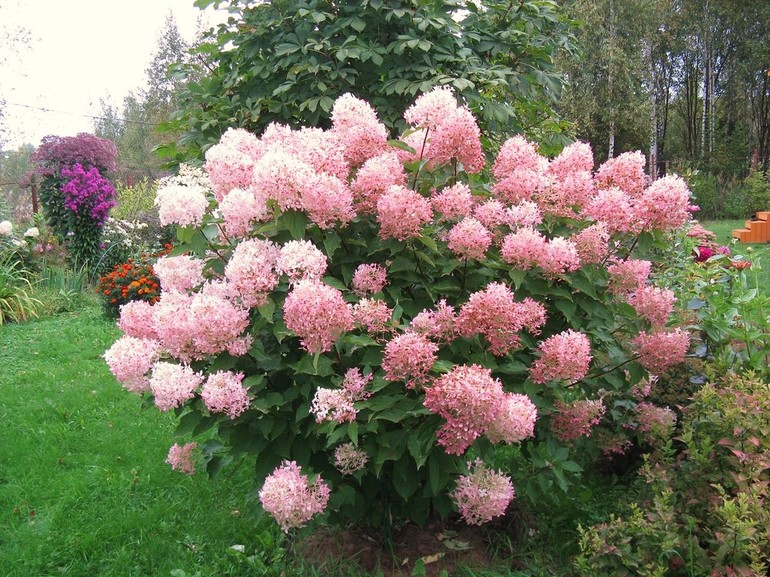 You may be interested in:
You may be interested in:It will take several years to form a really beautiful bush. In order not to get confused in the types of scraps, use the universal scheme. For the third season after planting, leave 5 or 6 of the best branches, completely remove the rest. After the first flowering, cut only the weakened and old shoots, you will get a strong and reliable foundation for the future shrub.
Pruning early flowering varieties
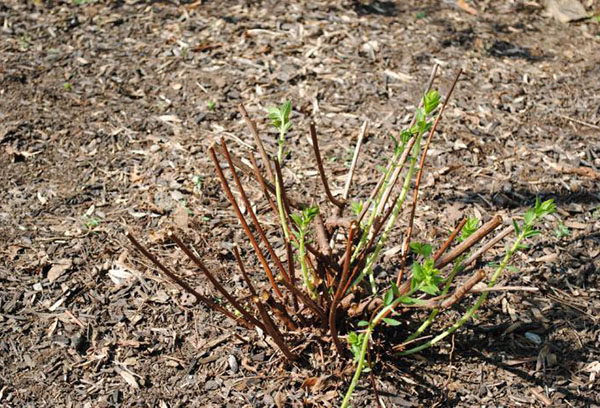
The flowering period occurs in May, in rare cases it begins from the first days of summer, inflorescences are formed on the shoots of last year, they are located along the entire length of the shoots. Plants show a tendency to build up a very large amount of overgrowth, which is why they require the mandatory cutting of part of the branches. In autumn, remove (to the root neck) at least a quarter of all shoots.
Do not forget that flower buds are laid on the shoots of the current year. In order not to spoil the appearance of the meadowsweet, cut off annual growths by a third of the length, such a procedure will be the key to more magnificent flowering. Cut branches with weak branching in half, remove one third of the length from each side stalk. In spring, you can remove only the frozen tips of branches.
Pruning late blooming varieties
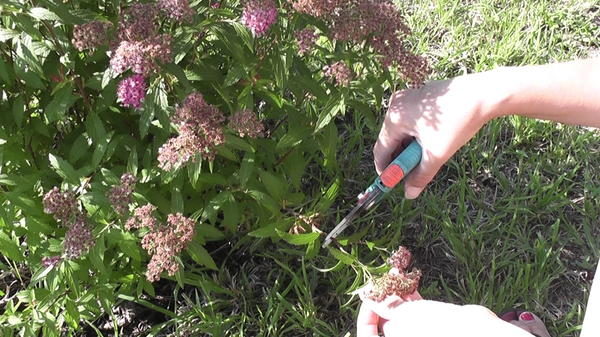
The flowering period falls on July-August, buds are formed on the growing branches. Numerous observations show that the more shoots of such species are removed in the autumn, the bush will be more magnificent for the next season. Cut all weak branches completely, and also remove excess shoots in spring or early autumn, leaving stumps no more than 3 buds.
Meadowsweet blooming in summer responds very well to moderate rejuvenation. However, such varieties age faster than early flowering ones; therefore, critical pruning to a stump will not give the desired result. Do not wait for the bush to become very old, as after 13 years, decorativeness is rapidly losing, uproot it, plant a young seedling of the same variety.
Care after trimming
Remove the area around the bush from debris and weeds, water the plant and fertilize. Be careful, complex feeding is recommended at the beginning of the growing season or until mid-summer. In autumn, it is advisable not to apply fertilizers, especially nitrogen fertilizers, the bush is preparing for a dormant period, and additional feeding will disrupt this process. In an extreme case, when the plant is weakened from the disease, apply the phosphorus-potassium mixture under the root according to the instructions.
When and How to Cover Spirea for the Winter
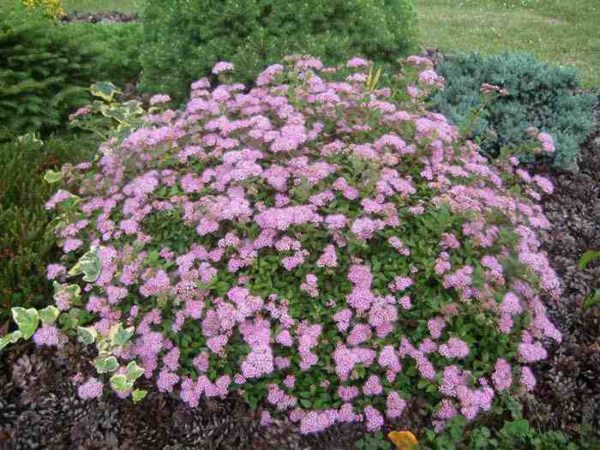
Protecting the meadowsweet from frost is quite simple, while some expensive, special materials are not required. In conditions of mild and snowy winters, a layer of mulch is laid up to 15 cm. Where severe and snowless winters are increased to 25 cm and wrapped in meadowsweet. Be sure to protect the branches of young and weakened shrubs, immunity to low temperatures in the plant manifests itself at 4 years of age. How to make sure that the covered bush does not bulge out:
- collect the shoots in a loose bunch, tie with a rope or fix with twine;
- cover the trunk circle with mulch;
- neatly bend the connected branches to the ground and secure them in any convenient way;
- lay dry leaves on the stems (layer 10-30 cm) so that the wind does not spread the mulch, crush it with dry branches.
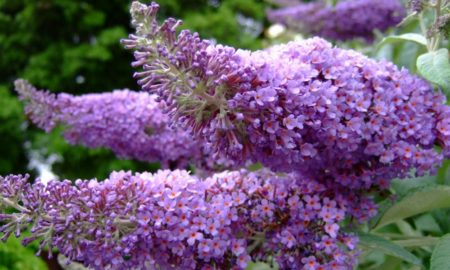 You may be interested in:
You may be interested in:In winter, if possible, throw snow over the shelter. Stalks can not be bent to the ground, but wrap a bunch in any heat-insulating material. An air-dry shelter for wintering spirea in harsh conditions is to organize an impromptu greenhouse. Install the frame above the bent shoots, tighten it on all sides with any waterproof material that retains heat.
Caring for spirea in the fall includes a number of mandatory, but very simple activities that cannot be ignored. The shrub is able to recover quickly, however, with improper pruning or improper shelter for the winter, most likely you will have to wait for the lush bloom until next year, is it worth the risk! Be sure to study the characteristics of planted varieties, then it will be easier for you to draw up a work plan for the fall.
Reviews and comments
Alyona
I like spirea because it lends itself easily and tolerates a haircut, you can shape it as you wish, and it’s very easy to take care of the bush. I planted species that bloom in different periods in turn, so I have a fence, elegant from spring to late summer. In recent years, she began to notice that with aging, Japanese spirea bushes are worse restored after low pruning, they have a tendency to expose the root neck.
Elisha
Practically everywhere there are recommendations regarding the removal of inflorescences as they wither. I do not do this, they do not spoil the appearance, so why not transfer the procedure to the season of the main pruning - autumn. I live in the Moscow region, I do not cover the branches of gray spirea, I only mulch the earth and pour snow, my friends from the Crimea do not protect the bush at all, their thermophilic varieties winter without consequences.
Natalya
I believe that spring pruning of the meadowsweet is necessary only for the purpose of preventing and improving the bush, I clean the branches that have not overwintered and dried up, I leave the main haircut in the fall (in the Urals in the first half of September). The last time I feed the bushes no later than August, was a bad experience, already after the pruning I applied fertilizers, young shoots went, the frost hit and their shelter, of course, did not save. The bush recovered quickly, but bloomed very poorly. In winter, I put arcs over bent branches, cover them with polyethylene, and sprinkle a layer of spruce branches on top.

 Sow in the ground, without seedlings: 10 beautiful and unpretentious flowers
Sow in the ground, without seedlings: 10 beautiful and unpretentious flowers Platicodon planting and outdoor care
Platicodon planting and outdoor care Hosta - planting and care in the open ground in the Urals
Hosta - planting and care in the open ground in the Urals Oleander - care and growing at home
Oleander - care and growing at home